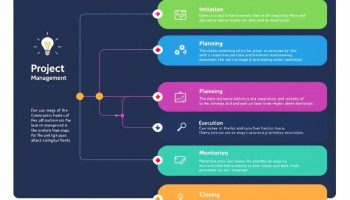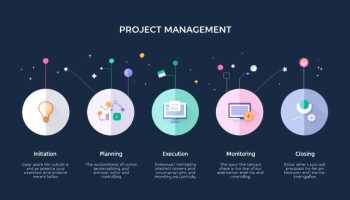
Understanding the Mendelow Stakeholder Matrix
The Mendelow stakeholder matrix serves as a practical business tool that sorts stakeholders according to their power and interest levels, creating four distinct quadrants for focused engagement. This analytical framework helps you pinpoint key stakeholders and craft suitable strategies for managing relationships with each group based on their potential impact and level of concern with project outcomes.
Why Mastering the Mendelow Stakeholder Matrix Drives Business Success
For businesses dealing with diverse stakeholder groups, the Mendelow stakeholder matrix offers a structured method to prioritize limited engagement resources effectively. By strategically directing attention based on stakeholder influence and interest, you can:
- Prevent project failures caused by overlooked high-power stakeholders
- Save resources by avoiding excessive focus on low-priority groups
- Develop stronger relationships that enable smoother implementation of initiatives
This systematic approach transforms stakeholder management from reactive firefighting to proactive planning that directly supports your business goals and enhances project results.
The matrix doesn’t just organize stakeholders—it provides clear direction on how to interact with each category. With power and interest as your guiding metrics, you’ll make better decisions about communication frequency, depth of information sharing, and engagement strategies.
Companies that apply the Mendelow stakeholder matrix consistently report more successful change initiatives, better risk management, and improved stakeholder satisfaction across projects of all sizes.
Companies that effectively engage stakeholders see up to a 60% improvement in project success rates.
The Mendelow Stakeholder Matrix
The Mendelow stakeholder matrix functions as a strategic analysis tool that helps you categorize and prioritize your stakeholders based on their power and interest levels. This practical framework transforms stakeholder management into a methodical process, enabling your team to allocate resources efficiently and create targeted communication plans. Stakeholder analysis becomes more straightforward when you can visually map relationships and influence.
The matrix divides stakeholders into four quadrants that require different engagement approaches: Key Players (high power, high interest) need your closest collaboration; Keep Satisfied (high power, low interest) require regular updates to maintain support; Keep Informed (low power, high interest) benefit from detailed communications; and Monitor (low power, low interest) need basic oversight. This classification gives you clear direction on how to manage each relationship type.
Using the Mendelow matrix helps you anticipate needs, prevent communication breakdowns, and build stronger project backing.
Step 1: Map Your Stakeholders by Power and Interest
The Mendelow stakeholder matrix helps you strategically analyze and prioritize project stakeholders based on their power and interest levels. To begin implementing this valuable tool, identify all potential stakeholders who might affect or be affected by your project outcomes. Next, assess each stakeholder’s level of power by evaluating their ability to influence decisions, control resources, or impact project success. Then determine each stakeholder’s interest level by gauging how invested they are in your project’s results.
Once you’ve analyzed these dimensions, plot each stakeholder on the matrix according to their specific power-interest combination. This visual representation will highlight which stakeholders require different engagement approaches. For complex projects, consider collaborating with a cross-functional team to ensure you capture diverse perspectives in your stakeholder analysis.
The completed Mendelow stakeholder matrix provides a clear framework for prioritizing your engagement efforts and developing targeted communication strategies for each group.
2. Develop Tailored Engagement Strategies for Each Quadrant
After mapping your stakeholders on the Mendelow stakeholder matrix, you need to create customized engagement approaches for each quadrant. The matrix helps you prioritize your efforts based on stakeholders’ power and interest levels.
For High Power, High Interest stakeholders (Key Players), develop comprehensive engagement plans that include regular meetings and direct involvement in decision-making. These individuals can significantly impact your project’s success, so investing time in collaborative project relationships with them is essential.
High Power, Low Interest stakeholders (Keep Satisfied) require efficient communication channels. While they may not be deeply invested in your project details, their support is crucial. Focus on concise updates that highlight benefits relevant to their priorities.
Low Power, High Interest stakeholders (Keep Informed) need consistent information sharing. These individuals care deeply about your project outcomes but have limited influence. Creating newsletters or forums keeps them engaged without requiring significant resources.
For Low Power, Low Interest stakeholders (Monitor), establish basic tracking systems. While these stakeholders currently have minimal impact on your project, their position in the Mendelow stakeholder matrix could change, so periodic monitoring is prudent.
Document your approach for each quadrant and create a communication plan that specifies the frequency, format, and content appropriate for each group.
Expert Insight: Tailor engagement strategies based on the Mendelow matrix. For key players, invest in collaborative relationships; for keep satisfied stakeholders, provide concise updates; keep informed stakeholders engaged through regular communication; and monitor low power stakeholders periodically. Document your strategies in a communication plan to ensure consistent delivery.
3. Implement Your Stakeholder Engagement Plan
After mapping stakeholders on the Mendelow stakeholder matrix, it’s time to put your engagement plan into action. The matrix categorizes stakeholders into four quadrants based on power and interest, helping you prioritize your efforts. For Key Players (high power, high interest), schedule regular face-to-face meetings to involve them in critical decisions. Their influence makes them essential partners in your project’s success.
Keep Satisfied stakeholders (high power, low interest) require strategic communication. Provide these influential individuals with concise updates that respect their time while maintaining their support. A brief monthly report or occasional consultation may be sufficient to ensure stakeholder satisfaction without overwhelming them.
For Keep Informed stakeholders (low power, high interest), develop consistent communication channels. These enthusiastic supporters appreciate newsletters, email updates, or access to information portals where they can follow your progress. Their interest makes them valuable advocates.
Establish minimal monitoring for stakeholders in the Monitor quadrant (low power, low interest). While they don’t require extensive engagement, tracking any changes in their position within the Mendelow stakeholder matrix remains important.
Assign specific team members to manage relationships with key stakeholders, creating clear accountability. Finally, implement feedback mechanisms to evaluate if your engagement approach is working effectively.
Expert Insight: Effectively implement your stakeholder engagement plan by tailoring communication strategies based on the Mendelow matrix. Prioritize face-to-face meetings with Key Players, concise updates for Keep Satisfied stakeholders, and consistent information sharing for Keep Informed stakeholders. Assign team members for accountability and establish feedback mechanisms to assess engagement effectiveness.
4. Review and Adjust Your Strategy Regularly
Successful implementation of the Mendelow stakeholder matrix requires ongoing attention and flexibility. You should schedule quarterly reassessments to evaluate if stakeholders have shifted positions within the matrix. As projects evolve, stakeholders who initially showed little interest might become more engaged, or power dynamics might change due to organizational restructuring.
When you notice stakeholders moving between quadrants, promptly adjust your engagement approach to match their new position. For example, if a previously low-interest stakeholder suddenly shows heightened concern, upgrade your communication frequency and depth accordingly.
Document specific engagement techniques that proved effective with different stakeholder types. This creates a valuable knowledge base for continuous improvement in your stakeholder management process. Consider these key points:
- Create a tracking system to monitor shifts in stakeholder influence and interest
- Implement formal feedback mechanisms to gauge stakeholder satisfaction
- Hold quarterly review meetings to reassess the Mendelow stakeholder matrix placement
- Document successful engagement techniques for future reference
- Build adaptability into your stakeholder communication plans
Making your stakeholder strategy cyclical rather than linear ensures you maintain appropriate relationships throughout the project lifecycle, even as priorities and positions change.
Expert Insight: Regularly review and adjust your stakeholder strategy by scheduling quarterly assessments to monitor shifts in influence and interest. Adapt your engagement approach based on stakeholder changes and document effective techniques for future reference. This cyclical approach ensures sustained relationships and alignment throughout the project’s evolution.
Optimizing Stakeholder Engagement with the Mendelow Matrix
The Mendelow stakeholder matrix serves as a powerful strategic tool for classifying and prioritizing stakeholders based on their power and interest levels in relation to your project. By following the four-step process—mapping stakeholders, developing tailored strategies, implementing engagement plans, and regularly reviewing your approach—organizations can effectively manage stakeholder relationships throughout the project lifecycle, ensuring appropriate communication and maintaining crucial support from key influencers while efficiently allocating resources.
Key Action Steps for Successful Stakeholder Management
- Identify all potential stakeholders who might affect or be influenced by your project
- Assess each stakeholder’s power level by evaluating their ability to influence decisions
- Determine stakeholders’ interest levels in your project’s outcomes
- Map stakeholders on the matrix according to their power-interest combination
- Develop comprehensive engagement plans for Key Players (high power, high interest)
- Create efficient communication channels for Keep Satisfied stakeholders (high power, low interest)
- Establish consistent information sharing for Keep Informed stakeholders (low power, high interest)
- Implement basic monitoring systems for low power, low interest stakeholders
- Assign team members to manage relationships with key stakeholders
- Schedule quarterly reassessments to evaluate shifts in stakeholder positions
Frequently Asked Questions
- What is the Mendelow stakeholder matrix? The Mendelow stakeholder matrix is a strategic tool that categorizes stakeholders into four quadrants based on their power and interest levels, helping project managers prioritize engagement efforts and develop appropriate communication strategies for each group.
- How do I determine a stakeholder’s power level? Evaluate their ability to influence decisions, control resources, or impact project success through their authority, financial control, or political influence within the organization.
- What communication approach works best for high power, low interest stakeholders? Provide concise, strategic updates that respect their time while highlighting benefits relevant to their priorities, using efficient communication channels like brief monthly reports or occasional consultations.
- How often should I review the stakeholder matrix? Schedule quarterly reassessments to evaluate if stakeholders have shifted positions, as project evolution can change stakeholders’ interest levels or organizational restructuring may alter power dynamics.
- What should I do if a stakeholder changes quadrants during the project? Promptly adjust your engagement approach to match their new position—for example, if a stakeholder’s interest increases, upgrade your communication frequency and depth accordingly.
- How can I track changes in stakeholder positions effectively? Create a dedicated tracking system to monitor shifts in stakeholder influence and interest, implement formal feedback mechanisms, and hold regular review meetings to reassess matrix placement.






